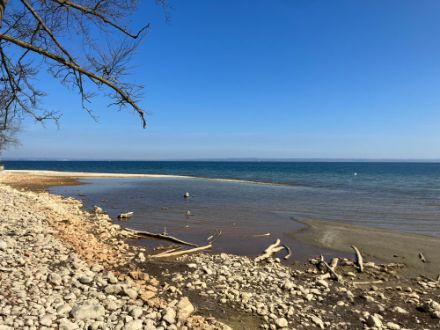Service Navigation
Search
Focus
- The combination of declining summer precipitation, higher temperatures and increased evaporation leads to increased soil drying in summer. Since the early 1980s, a decline in soil moisture of around 5 to 10 percent has been observed in Switzerland.
- In future, the current trend towards dry summers will intensify. With global warming of 3 degrees Celsius compared to pre-industrial levels, a summer drought that occurred once every ten years in the current climate (1991–2020) would occur three times more frequently.
- With global warming of 3 degrees Celsius, the number of days with a high weather-related forest fire danger will increase, for example from 18 to 44 days per year at the station Sion.
Drier summers are a growing challenge for Switzerland. The increasing lack of precipitation and simultaneous increase in soil water evaporation are having an increasingly negative impact on the supply of goods (for example via shipping), also on agriculture and forestry and on ecosystems.
Further information on the effects of climate change and measures taken by various sectors can be found on the website of the National Centre for Climate Services (NCCS).
Observed increase in drought in Switzerland
Since the early 1980s, a decline in soil moisture of around 5 to 10 percent has been observed in Switzerland. This change is due to several factors, one of the most important being a decrease in summer precipitation, which has also been observed since the early 1980s. This trend is consistent with projections for the future. In addition, rising temperatures cause more water to evaporate. Both solar radiation and sunshine duration (hours) have increased since the early 1980s, further stimulating evaporation.
Less snow in winter
The increasingly snow-scarce winters can further contribute to drought in spring. Snow-scarce winters leave insufficient snowmelt to replenish reservoirs for spring and summer. The snow deficit in winter reinforces the trend towards lower lake levels in spring.

Increasing number of dry days in spring since 1961
In spring, more than a third of MeteoSwiss stations have recorded a significant increase in the maximum number of consecutive dry days (precipitation < 1 mm) since 1961. This trend is particularly pronounced in western Switzerland, where the majority of stations have recorded a marked increase in consecutive dry days in spring.
There are other climate indices for drought that describe the current dryness or wetness at selected stations in the MeteoSwiss measurement network.
Future increase in summer drought in Switzerland
In future, the trend towards drier summers will intensify. This is due to both a further expected decline in average summer precipitation and faster soil drying caused by warmer and drier air. These long-term changes are overlain by significant natural year to year fluctuations, which are more pronounced than temperature variations. Humid summers will therefore still occur, though less frequently. On average, summers will become drier and already dry summers more extreme.

With global warming of 1,5 degrees Celsius compared to pre-industrial levels – in a so-called 1.5-degree world (GWL1.5) – a summer drought (defined by the water balance in summer) that occurred every ten years in the reference period 1991–2020 would occur about 1.6 times as often. In addition, it would be 17 percent drier on average. A 1,5-degree world is imminent.
In a 3-degree world (GWL3.0), such summer droughts would occur three times as often and be 44 percent drier, on average.
The following table shows the change in the intensity of a summer drought (water deficit) that occurs once every 10 years in Switzerland compared to the reference period 1991–2020. Shown are the expected values and the possible ranges of change. A summer drought is defined by the water balance in summer: rainfall minus the water that evaporates back into the air. If the result is negative, the soil dries out.
| 1.5-degree world | 2-degree world | 3-degree world | |
|---|---|---|---|
| Relative change | +17 % (-5 to +43 %) | +28 % (-2 to +47 %) | +44 % (+14 to +86 %) |
Fire weather

Increasing drought will significantly raise the risk of forest fires. Over the past 60 years, the potential for forest fires to start and spread has already increased in Switzerland. With even hotter and drier summers expected, the weather-related risk of forest fires will continue to rise. In a 3-degree world, the number of days with high weather-related fire risk will increase compared to the reference period 1991–2020, for example in Sion from 18 to 44 days. Days with high weather-related fire risk are defined as days with a fire weather index higher than 95 percent of the days in the period 1991–2020.

